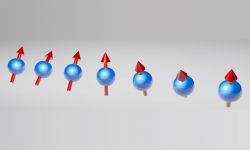
In an international first, Innsbruck Physicists have directly observed dynamical quantum phase transitions in an interacting many-body system.
Recent years have seen a surge of interest in out-of-equilibrium quantum many-body phenomena across the physical sciences. This surge has been fuelled by rapid experimental advances, which now make it possible to study exotic phenomena ranging from many-body localization to particle-antiparticle creation in the Schwinger model and light-induced superconductivity. However, further progress is hampered by the fact that, as of yet, no unifying theoretical framework exists to understand such dynamical phenomena on a general level. The recently proposed theory of dynamical quantum phase transitions (DQPTs) provides a promising concept towards achieving this major goal.
Recently, Innsbruck scientists led by Rainer Blatt and Christian Roos, presented the very first experimental observation and in-depth study of DQPTs in a quantum simulator. The scientists used a chain of linearly trapped ions, in combination with laser light-fields, to implement a many-body interacting system with an impressive high level of control over the single particles and their interactions. These interactions are tuned to implement a so called transverse Ising-model, a model of interacting magnets with an external magnetic field, in which the ions take the role of quantum magnets and the laser light-fields mediate the interactions between the magnets and the external field.
In the experiment, the scientists prepare the quantum magnets in the lowest energy state, the so called ground state, and immediately turn on the external magnetic field. This sudden change in the magnets environment induces a time dynamic that is carefully analyzed. In contrast to naturally occurring systems, the Innsbruck quantum simulator allows for individual particle control including single site resolution, that enables the scientists to restrict their measurements only to the ground states, i.e. projecting into the ground state manifold. Within this manifold an exotic, but by the DQPT-theory predicted behavior is observed: the magnetization of the ground state exhibits a non-analytical time evolution seen as sharp kinks; the defining characteristic of DQPTs.
Moreover, the scientists conducted an extensive study of DQPTs revealing an important relation between DQPTs and the generation of entanglement entropy, a measure of how much the magnets are entangled. It is shown that even though the entanglement entropy has a smooth time evolution, i.e. no abrupt changes such as kinks, the entropy bares the strongest growth in the vicinity of DQPTs, a feature unveiled by the Innsbruck study.
The work published in PRL provides a genuine and original new approach to investigate out of equilibrium systems. These results will strongly influence the understanding, interpretation, and experimental toolbox of future studies regarding the dynamics in interacting many-body systems.